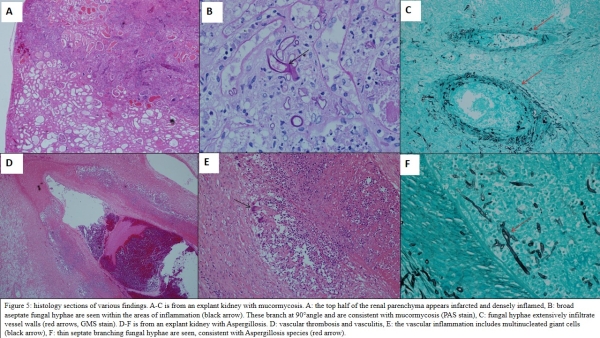Transplant Tourism and Invasive Fungal Infection
F. Al Ismaili,1 A. Metry,3 M. Al Riyami,5 F. Khamis,6 F. Shaheen,7 A. Hola,4 I. Al Salmi.2
1The Renal Medicine, The Royal Hospital, Muscat, Oman
2The Renal Medicine, The Royal Hospital, Muscat, Oman
3The Renal Medicine, The Royal Hospital, Muscat, Oman
4Histopathology, SQUH, Muscat, Oman
5Infectious Diseases, The Royal Hospital, Muscat, Oman
6SCOT, SCOT, RIyadh, Saudi Arabia
7The Renal Medicine, The Royal Hospital, Muscat, Oman
8The Renal Medicine, The Royal Hospital, Muscat, Oman.
Meeting: 2018 American Transplant Congress
Abstract number: A184
Keywords: Fungal infection, Graft function, Histology, Kidney transplantation
Session Information
Session Name: Poster Session A: Kidney Transplant Goes Viral
Session Type: Poster Session
Date: Saturday, June 2, 2018
Session Time: 5:30pm-7:30pm
 Presentation Time: 5:30pm-7:30pm
Presentation Time: 5:30pm-7:30pm
Location: Hall 4EF
Deceased and live-related Renal transplant (RTX) are widespread approved methods throughout the world. In-addition, commercial-RTX has gained an access at certain places driven by financial greed.
Invasive-fungal-infections (IFI) were evaluated in details from 2013-to-2015. 198 RTX, of whom 162(81.8 %) had commercial-RTX that were done abroad, as shown in Figure 1._throughout_3_years..jpg) IFIs were diagnosed in 8% of patients with commercial-RTX, of which 76.9 % underwent nephrectomy and 23.1 % continued with a functioning graft and none of the RTX done in Royal-Hospital (RH) had IFI. The most common fungal isolate was Aspergillus species. Computerized Tomography findings were infarction of graft, renal artery thrombosis, aneurysmal dilatation of external iliac artery, fungal ball or just presence of peri-graft collection. 23.1% died due to septic shock and 53.8 % were alive on hemodialysis. 23.1% of patients who did-not-undergo nephrectomy remained with acceptable graft function. Histological findings are shown in Figure 2.
IFIs were diagnosed in 8% of patients with commercial-RTX, of which 76.9 % underwent nephrectomy and 23.1 % continued with a functioning graft and none of the RTX done in Royal-Hospital (RH) had IFI. The most common fungal isolate was Aspergillus species. Computerized Tomography findings were infarction of graft, renal artery thrombosis, aneurysmal dilatation of external iliac artery, fungal ball or just presence of peri-graft collection. 23.1% died due to septic shock and 53.8 % were alive on hemodialysis. 23.1% of patients who did-not-undergo nephrectomy remained with acceptable graft function. Histological findings are shown in Figure 2. Commercial RT accounts for almost 75% of RTX in Oman. The setups of the transplant facilities were inappropriate with poor infection control measures. In fact, the surgeries were performed by underground networks in order to escape possible legal consequences. Aspergillus was the main isolated fungi with no Candidabeing cultured. All of the patients had an indolent clinical presentation which posed a great diagnostic challenge. Therefore, high index of suspicion remains the best approach in dealing with such cases.
Commercial RT accounts for almost 75% of RTX in Oman. The setups of the transplant facilities were inappropriate with poor infection control measures. In fact, the surgeries were performed by underground networks in order to escape possible legal consequences. Aspergillus was the main isolated fungi with no Candidabeing cultured. All of the patients had an indolent clinical presentation which posed a great diagnostic challenge. Therefore, high index of suspicion remains the best approach in dealing with such cases.
CITATION INFORMATION: Al Ismaili F., Metry A., Al Riyami M., Khamis F., Shaheen F., Hola A., Al Salmi I. Transplant Tourism and Invasive Fungal Infection Am J Transplant. 2017;17 (suppl 3).
To cite this abstract in AMA style:
Ismaili FAl, Metry A, Riyami MAl, Khamis F, Shaheen F, Hola A, Salmi IAl. Transplant Tourism and Invasive Fungal Infection [abstract]. https://atcmeetingabstracts.com/abstract/transplant-tourism-and-invasive-fungal-infection/. Accessed January 4, 2026.« Back to 2018 American Transplant Congress
